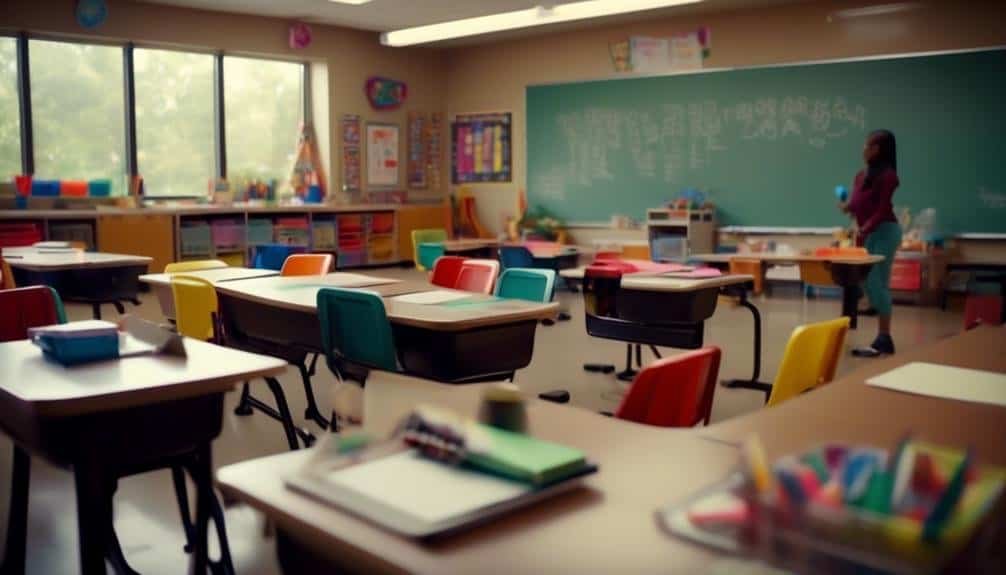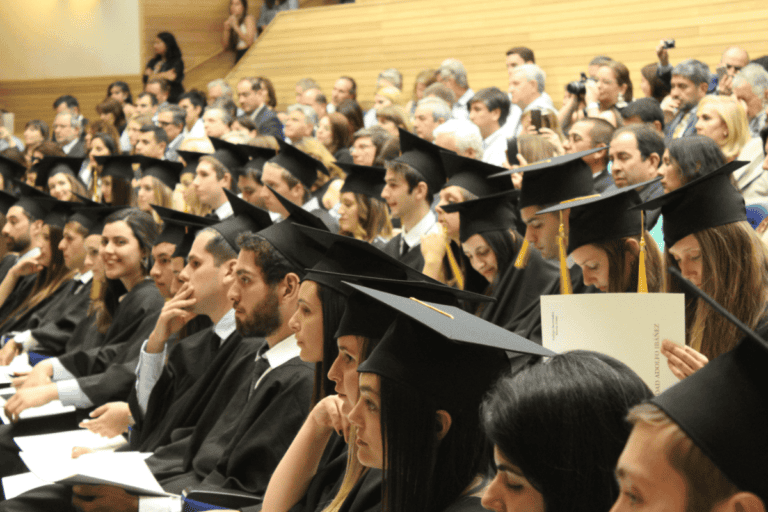Classroom Management Strategies for Teachers
In the chaotic realm of the classroom, where order seems elusive and chaos reigns supreme, teachers are faced with the daunting task of maintaining control and fostering a conducive learning environment.
But fear not, for there is hope! By employing a repertoire of effective classroom management strategies, you can transform your classroom into a well-structured, engaging space where students thrive and learning flourishes.
So, how exactly can you achieve this seemingly elusive feat?
Key Takeaways
- Setting clear expectations and involving students in the process promotes a productive learning environment and encourages responsibility.
- Building rapport with students fosters trust and respect, creating a positive classroom culture.
- Implementing clear and consistent rules, using positive reinforcement, and addressing misbehavior promptly and calmly are effective behavior management techniques.
- Engaging students through active learning techniques, collaborative group work, hands-on activities, and real-world problem-solving promotes student engagement and participation.
Establishing Clear Expectations
To effectively manage your classroom, it's crucial to establish clear expectations for your students. By setting clear expectations, you provide your students with a clear understanding of what's expected of them, which can lead to a more productive and harmonious learning environment.
When establishing clear expectations, it's important to clearly communicate your rules and guidelines to your students. This can be done through a classroom discussion or by creating a set of written rules that are prominently displayed in the classroom. By involving your students in the process of establishing expectations, you can help them take ownership of their behavior and encourage a sense of responsibility.
Building rapport with your students is also essential in establishing clear expectations. By creating a positive and supportive classroom environment, you can foster a sense of trust and respect between you and your students. This can lead to improved behavior and a greater willingness to adhere to the expectations you have set.
Creating a Positive Classroom Culture
Establishing clear expectations is just the first step in creating a positive classroom culture where students feel valued and motivated to learn. Building relationships and fostering a positive environment are essential components in achieving this goal.
Here are two ways you can create a positive classroom culture:
- Encourage open communication:
- Create an atmosphere where students feel comfortable expressing themselves and sharing their thoughts and ideas.
- Actively listen to your students and encourage them to listen to each other, fostering respect and understanding.
- Promote collaboration and teamwork:
- Assign group projects and activities that require students to work together and support one another.
- Encourage students to appreciate and value the diverse perspectives and strengths of their classmates.
Implementing Effective Behavior Management Techniques
One effective way to manage behavior in the classroom is by implementing clear and consistent rules that promote a positive learning environment. Behavior modification techniques can be used to encourage desired behaviors and discourage negative ones.
Positive reinforcement is an essential tool in behavior management. By rewarding students for exhibiting appropriate behavior, you can reinforce their positive actions and motivate them to continue behaving well. This can be done through verbal praise, small rewards, or even a simple thumbs-up.
It's important to clearly communicate the rules and expectations to your students from the beginning and consistently enforce them. This will help establish a predictable and structured environment, which is conducive to learning. Be sure to model the behaviors you expect from your students and provide them with ample opportunities to practice and demonstrate those behaviors.
If a student misbehaves, it's important to address the behavior promptly and calmly. Use redirection or logical consequences to help the student understand the impact of their actions.
Promoting Student Engagement and Participation
To promote student engagement and participation in the classroom, you can employ active learning techniques and encourage collaborative group work.
Active learning techniques involve getting students actively involved in the learning process, such as through hands-on activities or discussions.
Collaborative group work allows students to work together, fostering teamwork and enhancing their communication and problem-solving skills.
Active Learning Techniques
Engage your students and foster active participation in the classroom through effective active learning techniques. By implementing a student-centered approach, you can create a dynamic and engaging learning environment that promotes deeper understanding and critical thinking.
Here are two key strategies to consider:
- Collaborative Learning:
- Encourage group work and discussions to promote active participation.
- Assign group projects that require students to work together towards a common goal.
- Problem-Based Learning:
- Present real-world problems or scenarios for students to analyze and solve.
- Encourage students to actively engage in the problem-solving process by asking questions and seeking solutions.
These active learning techniques not only enhance student engagement but also foster a sense of ownership and responsibility for their own learning. By incorporating these strategies, you can create a classroom environment where students are actively involved in their own education.
Collaborative Group Work
Implementing collaborative group work in the classroom is an effective strategy to promote student engagement and participation. By assigning collaborative group projects, you encourage students to work together, share ideas, and actively participate in their learning process. Cooperative learning methods, such as group discussions, debates, and problem-solving activities, foster critical thinking, communication skills, and teamwork. This table illustrates the benefits of collaborative group work:
| Benefits of Collaborative Group Work |
|---|
| Enhances critical thinking skills |
| Improves communication skills |
| Encourages active participation |
| Fosters teamwork and collaboration |
Utilizing Effective Communication Strategies
Effective communication strategies are essential for teachers to maintain a well-managed classroom environment. By utilizing effective listening techniques, teachers can better understand their students' needs, concerns, and learning styles. This allows for more personalized instruction and fosters a sense of trust and respect between the teacher and students.
Additionally, nonverbal communication plays a crucial role in classroom management. Teachers can use body language, facial expressions, and gestures to convey messages and expectations to students. This helps to establish clear boundaries and promotes a positive classroom atmosphere.
To further enhance communication in the classroom, teachers can implement the following strategies:
- Active Listening: Encourage students to express their thoughts and opinions while actively paying attention to their responses. This demonstrates that their ideas are valued and promotes engagement.
- Visual Cues: Utilize visual aids, such as charts or diagrams, to enhance understanding and engagement. Visual cues can also be used to indicate transitions or reinforce important information.
Incorporating Active Learning Strategies
To create an engaging classroom environment, you can incorporate active learning strategies such as engaging group activities, interactive technology tools, and kinesthetic learning exercises.
These strategies encourage student participation and help them retain information more effectively.
Engaging Group Activities
Get your students actively engaged in the learning process through a variety of dynamic group activities. Incorporating group brainstorming and cooperative learning strategies can enhance student engagement and promote collaborative problem-solving skills. Here are some effective group activities you can implement in your classroom:
- Group Brainstorming:
- Encourage students to generate ideas collectively.
- Foster a supportive environment where all ideas are valued.
- Use visual aids or graphic organizers to facilitate idea generation.
- Cooperative Learning:
- Assign group projects that require students to work together towards a common goal.
- Design activities that promote equal participation and shared responsibility.
- Provide clear guidelines and roles to ensure each student contributes.
Interactive Technology Tools
Incorporating interactive technology tools into your classroom can greatly enhance active learning strategies.
Interactive technology integration refers to the use of digital classroom tools that engage students and promote collaboration and participation. These tools can include interactive whiteboards, tablets, smartphones, and educational apps.
By incorporating these tools, you can create a more dynamic and interactive learning environment. For example, interactive whiteboards allow you to display multimedia content, annotate and highlight information, and encourage student participation.
Tablets and smartphones enable students to access educational apps and online resources, fostering independent and personalized learning experiences.
Digital classroom tools also provide opportunities for formative assessment, allowing you to gather real-time feedback and adjust your teaching accordingly.
Kinesthetic Learning Exercises
Engage your students in active learning through kinesthetic exercises that promote physical movement and hands-on experiences. Incorporating physical movement in the classroom can enhance student engagement, improve retention, and foster a positive learning environment.
Here are two sub-lists that highlight the benefits and examples of kinesthetic learning exercises:
Benefits of Physical Movement:
- Increases blood flow and oxygen to the brain, enhancing cognitive function.
- Releases endorphins and reduces stress, creating a positive and conducive learning environment.
Examples of Learning through Play:
- Simon Says: Incorporate academic content into the game to reinforce learning.
- Charades: Act out vocabulary words or historical events to encourage memory recall and understanding.
Providing Individualized Support and Differentiation
To effectively support and differentiate instruction for each student, it's crucial for teachers to personalize their approach based on individual needs and learning styles. One way to achieve this is through individualized assessments.
By assessing students' strengths, weaknesses, and learning preferences, teachers can gain valuable insights into how to tailor their instruction to meet each student's unique needs. This may involve using a variety of assessment methods such as observations, interviews, and informal assessments to gather information about students' abilities and interests.
Once individualized assessments have been completed, teachers can then use this information to implement differentiated instruction. This approach involves modifying instruction and activities to accommodate the diverse learning needs of students. For example, teachers may provide additional support or scaffolding for struggling learners, while challenging advanced learners with more complex tasks.
Differentiated instruction can also involve utilizing various teaching strategies, materials, and resources to cater to different learning styles, such as visual, auditory, or kinesthetic.
Managing Transitions and Routines
Effectively managing transitions and routines is essential for creating a structured and organized classroom environment. By implementing strategies to manage transitions and establishing consistent routines, you can optimize instructional time and minimize disruptions in your classroom. Here are some key points to consider:
- Managing Transitions:
- Clearly communicate expectations: Set clear expectations for how students should transition between activities or tasks.
- Use visual cues: Display visual cues, such as a countdown timer or a signal, to indicate when a transition is about to occur.
- Provide transition activities: Engage students in brief activities or exercises during transitions to keep them focused and minimize downtime.
- Establishing Routines:
- Develop a daily schedule: Create a structured daily schedule that includes consistent routines for specific activities, such as morning routines or transitioning to different subject areas.
- Teach and practice routines: Explicitly teach and practice routines with your students, ensuring they understand the expectations and procedures for each routine.
- Reinforce positive behavior: Recognize and reinforce positive behavior during routines to encourage students to follow the established procedures.
Utilizing Technology for Classroom Management
Now let's explore how technology can be effectively utilized for managing your classroom.
Technology integration has become an essential tool for teachers to enhance classroom management. By incorporating digital tools for behavior management, you can streamline your classroom routines, engage students, and promote a positive learning environment.
Digital tools such as behavior management apps and online platforms allow you to track and monitor student behavior in real-time. These tools provide a convenient way to document and analyze student behavior, helping you identify patterns and address any issues promptly. Additionally, many behavior management apps offer features like reward systems, allowing you to incentivize positive behavior and motivate your students.
Another effective use of technology in classroom management is the use of interactive whiteboards and multimedia presentations. These tools offer a visually stimulating and engaging way to deliver lessons, capture students' attention, and keep them focused. Additionally, interactive whiteboards allow for collaborative learning, enabling students to actively participate in the lesson and share their ideas.
Furthermore, online tools and platforms can facilitate communication and collaboration between teachers, students, and parents. Platforms like Google Classroom or learning management systems provide a centralized hub for sharing assignments, resources, and announcements. This streamlined communication can help keep everyone informed and organized.
Conclusion
To effectively manage a classroom, teachers must establish clear expectations, create a positive classroom culture, and utilize effective behavior management techniques.
One interesting statistic shows that implementing active learning strategies increases student engagement by 73%.
By incorporating technology, providing individualized support, and managing transitions and routines, teachers can create an environment conducive to learning and student success.
With effective communication strategies and a focus on promoting student participation, teachers can ensure a productive and engaging classroom experience for all students.







